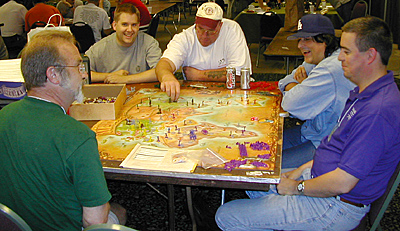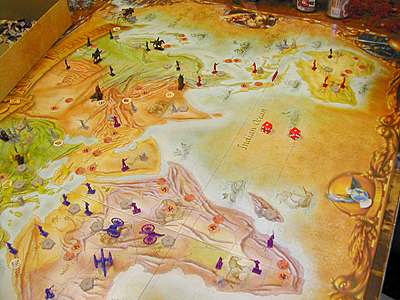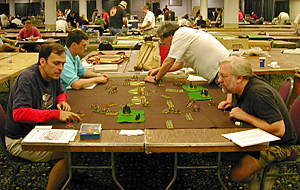 On Friday night, we sat down to play Eagle Games' War: Age of Imperialism. Technically, it's a boardgame, but it includes 20mm plastic figures and is relatively quick to pick up. Think of it as Risk with extras. In fact, we played the Basic rules, and it offers Standard and Expert rules too. But with only two of us six having played once, Basic would be just fine.
On Friday night, we sat down to play Eagle Games' War: Age of Imperialism. Technically, it's a boardgame, but it includes 20mm plastic figures and is relatively quick to pick up. Think of it as Risk with extras. In fact, we played the Basic rules, and it offers Standard and Expert rules too. But with only two of us six having played once, Basic would be just fine.
The Six Amigos: John Miller (green shirt), Tibor Vari (blue shirt), Steve Phenow (baseball cap), Mark Conover (moving), and Steve Hojnacki (grey shirt). Russ Lockwood (taking the photo)
War: Age of Imperialism starts you out with each player picking four areas on the board and 120 points worth of troops (infantry = 10, cavalry = 15, artillery = 20, ships = 25, leaders = 40, and explorers = 10) and buildings (cities, ports, forts, etc all = 20).
The remaining areas are covered with two types of round counters: natives and resources. Native counters provide an inherent strength of an area. Most contain just infantry, but on occasion, the natives get cavalry and artillery. The counter is face down, so you don't know the exact strength (between 4 and 12, mostly 9-12) until you land on it. Likewise, the resource counter is placed face down in an are. If you defeat the natives, you get the resource (points for building). About a third of the time there's something there, but as for the other two-thirds, you get bupkus...i.e. no points.
To add a native area to your empire, you choose between two options: either send in an explorer, or send in a military force. The explorer gives you a 2d6 roll. If your roll equals or exceeds the native strength printed on the counter, the natives are pacified, you add the territory, and gain the resource (if any). If not, the explorer gets eaten...i.e. eliminated.
Battle
If you send in the military, your pieces fight the natives. In the Basic game, when two opposing forces are in the same area, it's a fight to the death--only one can remain at the end. In other other games, the attacker has the option to withdraw.
In the Basic game, the attacker selects one of his units and declares an attack on one of the defending units. Each piece gets a die roll modifier: infantry +0, cavalry +1, artillery +2, and leader +3. Both players roll 2d6, add the modifier, and high total eliminates low total (ties re-roll). This continues until one side or the other is eliminated from the area. Like Risk, each area needs to be garrisoned by one unit. Explorers are automatically eliminated if in battle.
Ship battles are slightly different. Each ship gets a 2d6 roll for a 9+ to hit. One hit sinks an opposing ship.
The game play sequence runs: all players move and resolve explorers/attacks, all players move and resolve explorers/attacks a second time, and then build new units.
Build
Each area that you control may hold one revenue-producing "building" (factory, port, city, and railway). Each produces 10 points. Since you start with 120 points and four areas, you can build four buildings and four infantry and hope nobody attacks you. Then, the next turn, you start with 40 points. Most players opted for a more conservative strategy, buying two buildings, the requisite four infantry, an explorer or two, and more infantry.
At game start, we picked an area and placed the units/buildings one at a time. Generally, since one area was pretty much the same as another, we picked what we sat in front of. I generally was in North Africa, Tibor in South Africa, John in West Europe, Steve in Russia/Central Asia, Mark in China, and Steve P. in Australia.
 First Few Turns
First Few Turns
Resource scarcity means that you can, with luck, take an area or perhaps two on the first go around. Usually, after your explorer gets eaten, you pass. This goes on for a few full turns. Then, as the territory starts to expand, and you start to place revenue-producing buildings on areas, your army gets a little larger.
After a few turns: still few troops, many natives.
It was Steve Russia who initiated hostilities by declaring that it was cheaper to take a city from another player than to attack natives. He struck John in Eastern Europe, which started a see-saw battle that saw many losses and no gains. Meanwhile, in Africa, the continent pretty much divided and natives pacified, Russ struck southward, hoping the war in Europe would tie up John's attention. Despite overwhelming odds, Russ only captured half his objectives, as Tibor valiantly held out.
At this point, Steve Russia offered up a suggestion to Tibor to counterattack heavily, where Russ withstood overwhelming odds, leaving Tibor with explorers holding key areas. Russ moved in.
Over the next couple turns, Russ mopped up the southern part of Africa, but Tibor staged a comeback from Arabia, cascading into the northern part of Africa. Then, Steve Russia, who had expanded into India, jumped an army on a ship and struck Russ on the east coast of Africa, capturing a city and subsequently building new units and a Fort (+1 to all units when on defense). Russ built units, too, but when down in the southern part, could not shift the army north. The newly built army would have to do. Attacking at a disadvantage, the winds of fortune blew his way and Steve Russia's toehold in Africa was vanquished.
Tibor took advantage and headed west across the top of heavily urbanized Africa, falling just short of taking Casablanca and its big point Diamond Mine (resource). This was when Perfidious John stabbed Russ by sending an army across the Med and into Tunisia, weakly held by Tibor with a single infantry, and then another force to hit Casablanca. He took Tunisia, but was repelled at Casablanca, and then steadfastly refused to evacuate Tunisia. On the next build phase, Russ retook Tunisia and put two ships outside Gibralter. John countered with two ships and the one in the Med, and the first sea battle resulted in Russ' fleet sunk and John with two ships.
By this time, Mark's Chinese empire had expanded enough to take out Steve Russia. Tibor was gone, too, leaving four players: Russ Africa, John Europe, Mark China, and Steve Australia. At this point, Steve's Australians sent an expeditionary force across the Indian Ocean heading towards Africa, and Mark began his attack on John...and there were a lot of Chinese. It was a bloodbath in Afghanistan for both sides.
Gambling that John again had enough problems of his own, Russ built four ships and jumped the Australian force, sending it to the bottom, but taking a loss in turn. Steve moved up additional ships and counterattacked, only to be sunk, but reducing Russ' fleet to one ship. That's when the Chinese attacked with its one navy, which was quickly sent to the bottom. Russ built more ships and attacked Steve's remaining ships, eventually making the Indian Ocean an African lake.
And that's where the game, which lasted from 8:30pm to 1:30am, ended. China had the most production, followed by Australia, Europe, and Africa. China also had the most units, followed by Europe, Australia, and Africa. Still, there was plenty of fight left for another 5 hours of play before one person could be declared a winner--and we weren't ready to pull an all-nighter. The balance of power meant that anyone trying to go after the weakest player, Russ' Africa, would become vulnerable to a concentrated attack by the other two.
Conclusion
War: Age of Imperialism is a very clever extension to Risk. It looks good, it plays well, and all players have a chance to win. Even though four of the six had never played it before, they picked up up quickly. At $60, it's slightly pricier than most boardgames, but there's plenty in the box to justify the cost.
The only caveat is that a full game takes a long time. In the four-player game I played before, the same thing happened. You get a relatively quick kill on a player, and then the others are left in a stalemate that needs a run of luck, or a gang up, to break. The trouble with a gang up is that one member of the gang usually takes more losses than the other, and no one wants to be the weakest winning member of the pack.
Standard and Advanced Rules offer far more choices, including engineer units, development of technology, and so on. I suspect that this will only add more time needed to play a game. Of course, you can always choose to limit the time--we played until exhaustion--or limit the geography--two sections of the board instead of all three.
War: Age of Imperialism is an excellent game and recommended for anyone's collection. You might need a goodly amount of time to finish a game, but you'll enjoy the entire range of strategic and tactical options of doing so.
 Not W:AoI, but a quartet of ancients buffs enjoying the Open Gaming area near us. Playing Warrior is: Dan Burkley (left, dark blue), Fred Stratton (left light blue), Rich Pichnarczyk (right black), and Dennis Shorthouse (right, white).
Not W:AoI, but a quartet of ancients buffs enjoying the Open Gaming area near us. Playing Warrior is: Dan Burkley (left, dark blue), Fred Stratton (left light blue), Rich Pichnarczyk (right black), and Dennis Shorthouse (right, white).
More Historicon 2002
- Welcome and Introduction
Registration and Tournaments
DBA On-line
Flea Market: Bargains
The Theater: Big Wargames
Re-enactors: British and French
Distelfink Ballroom: Main Gaming
Back Out in the Hallway
"Courier" Room
Dealer Area: Tennis Barn
Don Featherstone
Steve Phenow, Strategikon
Restaurants and Restaurant Fires
War: Age of Imperialism (review)
Back to List of Conventions
Back to Travel Master List
Back to MagWeb Master List of Magazines
© Copyright 2002 by Coalition Web, Inc.
This article appears in MagWeb (Magazine Web) on the Internet World Wide Web.
Other military history articles and gaming articles are available at http://www.magweb.com